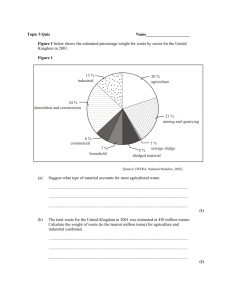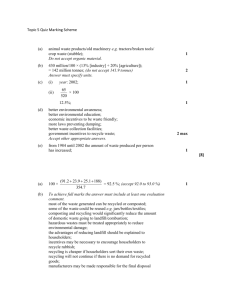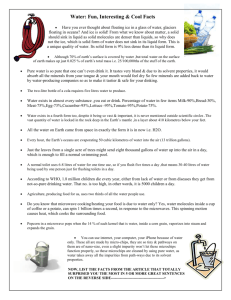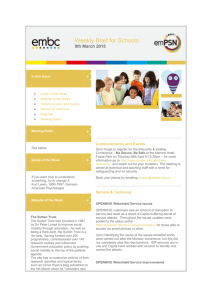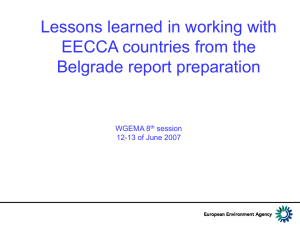Забор пресных вод (Fresh water abstraction)
advertisement
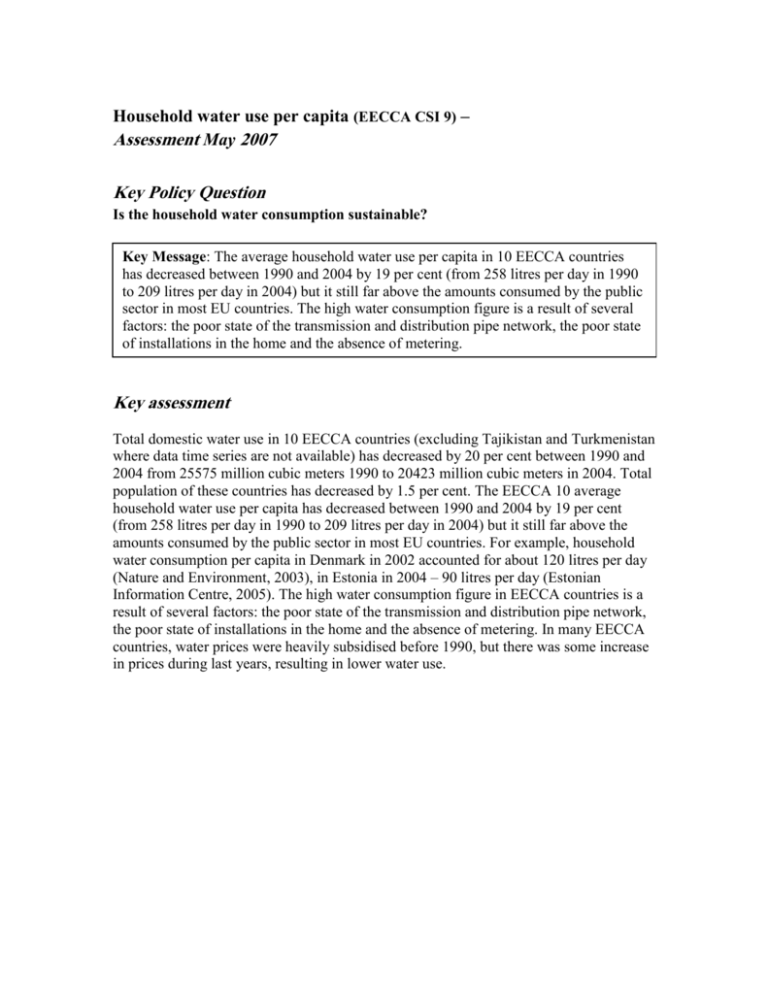
Household water use per capita (EECCA CSI 9) – Assessment May 2007 Key Policy Question Is the household water consumption sustainable? Key Message: The average household water use per capita in 10 EECCA countries has decreased between 1990 and 2004 by 19 per cent (from 258 litres per day in 1990 to 209 litres per day in 2004) but it still far above the amounts consumed by the public sector in most EU countries. The high water consumption figure is a result of several factors: the poor state of the transmission and distribution pipe network, the poor state of installations in the home and the absence of metering. Key assessment Total domestic water use in 10 EECCA countries (excluding Tajikistan and Turkmenistan where data time series are not available) has decreased by 20 per cent between 1990 and 2004 from 25575 million cubic meters 1990 to 20423 million cubic meters in 2004. Total population of these countries has decreased by 1.5 per cent. The EECCA 10 average household water use per capita has decreased between 1990 and 2004 by 19 per cent (from 258 litres per day in 1990 to 209 litres per day in 2004) but it still far above the amounts consumed by the public sector in most EU countries. For example, household water consumption per capita in Denmark in 2002 accounted for about 120 litres per day (Nature and Environment, 2003), in Estonia in 2004 – 90 litres per day (Estonian Information Centre, 2005). The high water consumption figure in EECCA countries is a result of several factors: the poor state of the transmission and distribution pipe network, the poor state of installations in the home and the absence of metering. In many EECCA countries, water prices were heavily subsidised before 1990, but there was some increase in prices during last years, resulting in lower water use. Fig. 1. Household water use per capita in EECCA countries in 1990, 2000, 2002 and 2004 600 litres/day per capita 500 400 1990 300 2000 2002 2004 200 100 Ar m en ia Az er ba ija n Be la ru s G eo rg Ka ia za kh st an Ky rg yz st an M ol do va Ru ss ia Uk ra in Uz e be ki st an 0 Note: Data time series on household water consumption are not available for Tajikistan and Turkmenistan. Data source: Data on household water consumption from the CIS STAT CD 2005 and 2006 (verified by the national statistics); data on population from the World Bank’s World Development Indicators data base. As show Figure 1 the household water use per capita and trends since 1990 differ by countries. One should however take into consideration the fact that showed data present an average for country indicator. In some urban regions and especially in rural areas this indicator is much lower. In some countries there is a large rural population not connected to the public water supply. Some studies show that household water use in some rural areas in Ukraine, for instance, amount about 34 liters per person per day (GAP, 2006). Average water supply coverage in Azerbaijan is estimated at 50%, with coverage in rural areas at 11%. In Russian Federation in 2004 the centralised water supply network covered 108 million inhabitants, i.e. 75% of the country’s population (SoER of the Russian Federation, 2005). As no water supply is metered, it is difficult to estimate the losses in distribution. The losses in the supply system can be up to 30% of the virtual consumption even in western European countries (2nd Baltic State of Environment Report, Baltic Environmental Forum, 2000). In Armenia, for examples the losses in the distribution network range by estimation from 40 per cent to 65 per cent (37 per cent in Yerevan). The conditions of the pumping stations and drinking water supply systems in rural areas that are operated by local communities are worse that in the urban areas. Individual water meters are installed only in very few cases, and it is therefore impossible to determine the actual per capita consumption. Households with water meters installed generally use less water than households without meters and there is a much higher incentive to save water when the water price is increased. Water pricing is an example of one of the measures used to reduce water demand. In Estonia, for example, water prices increased markedly after subsidies were removed, which in conjunction with water measuring and application of more advanced sanitation devices led to a more than 50 % reduction in water use during the last 15 years (from 188 litres/day per capita in 1992 to 90 litres/day per capita in 2004). Methodology and references How did we create this indicator? See UNECE Guidelines for the Application of Environmental Indicators in Eastern Europe, Caucasus and Central Asia for methodology, rationale and more relevant details about this indicator. http://www.unece.org/env/europe/monitoring/Belgrade/CRP1.Indicators.En%20edited.MK..pdf

